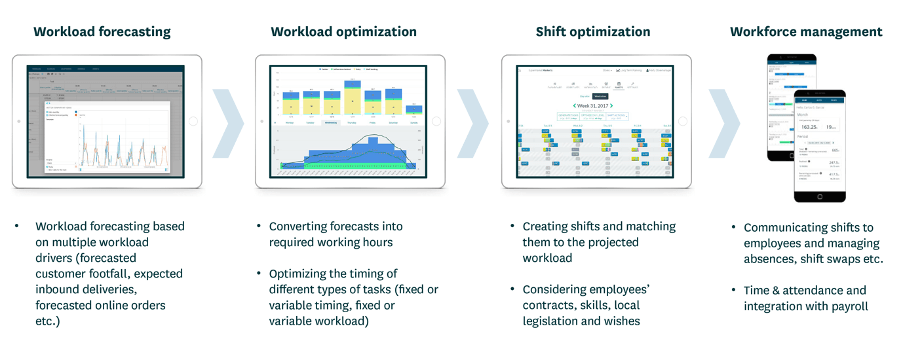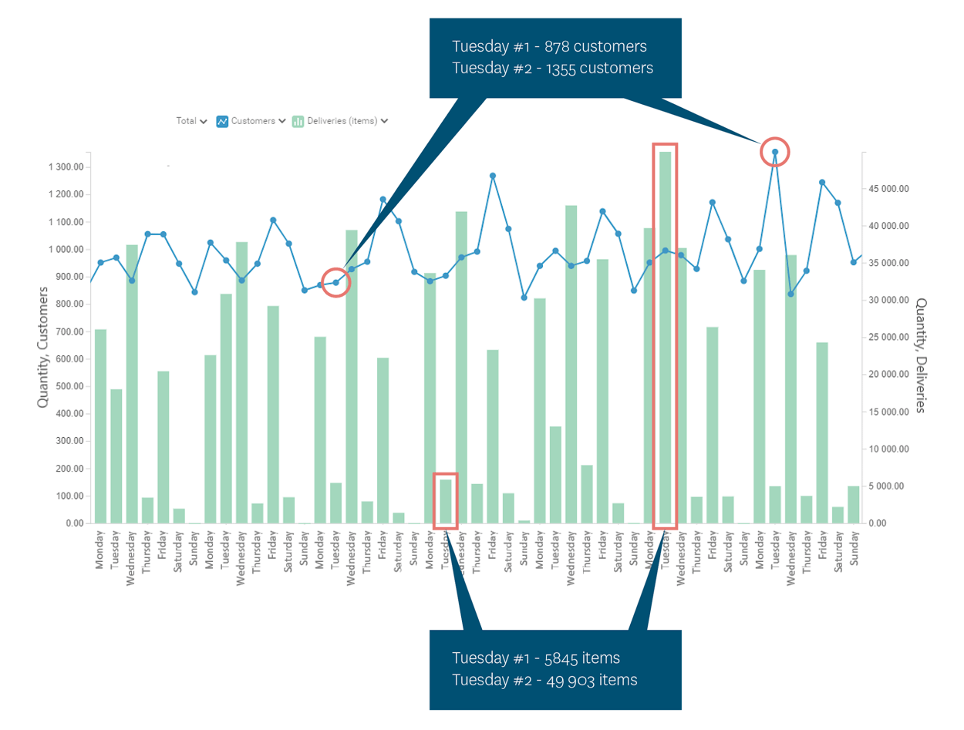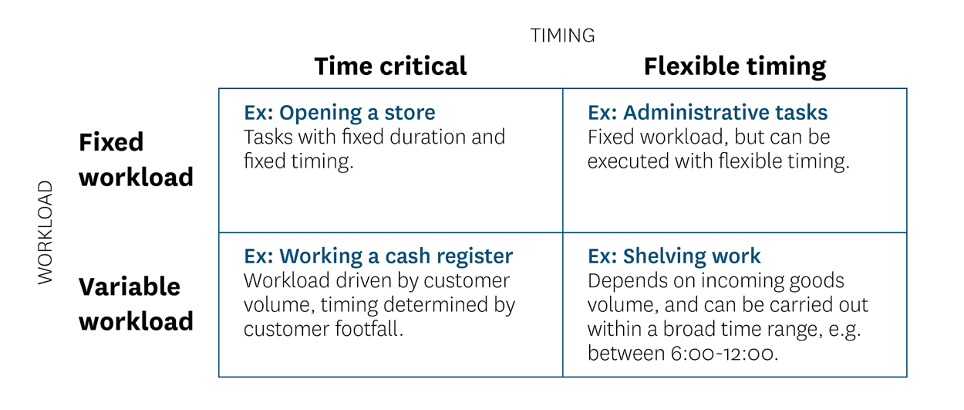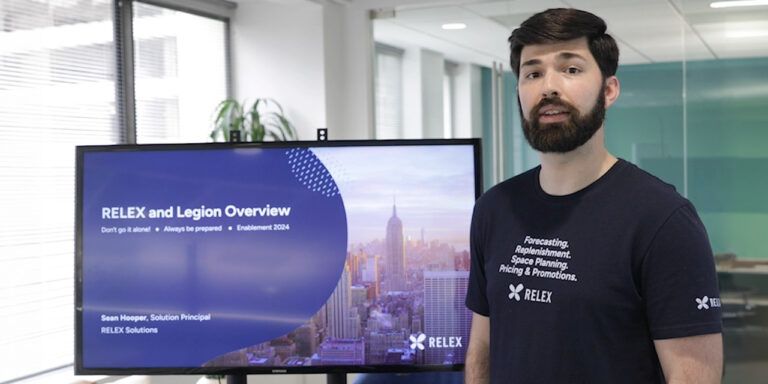While retailers’ recent investments in automation, such as self-service check-outs or robots scanning shelves and aisles, tend to get noticed by the broader industry, a less discussed but very prominent trend is that more and more tasks are being added to stores that are harder to automate. For example:
- Store employees are more likely to need to prepare products, from grocery employees baking bread to hardware store employees mixing paint or cutting lumber.
- Many retailers have added services beyond their initial business scope as a means of increasing margins or adding value. For example, grocery stores in some countries now offer banking options, while tech retailers offer installation and insurance services.
- As retailers embrace omnichannel strategies, store employees are increasingly called on to handle the picking of online orders and the management of consumer returns—on top of their standard duties.
Thus, even with the rise in automation and AI, there is a parallel understanding that one of brick-and-mortar retailers’ biggest assets – and biggest operational costs – is staff. For most retailers, store personnel account for approximately 10-20% of total revenue. By making strategic investments in the human side of their business, retailers can offer additional, unique value. However, many retailers are currently facing a need to compete for store talent without being able to afford increased operational costs.
The good news is that most retailers could easily reduce their workforce costs by up to 10% while at the same time offering their staff more predictable and well-balanced work shifts by leveraging AI to predict workload and optimize rosters accordingly.
So how can retailers leverage workforce optimization to be more efficient, save time and money, and improve their employees’ experience?
1. Workforce Optimization Outperforms Workforce Management
Today’s store managers are tasked with an enormous challenge. They must create shift schedules that satisfy three things at the same time–matching shifts to the forecast workload; complying with all rules and restrictions, including laws, collective agreements, and contracts; and aligning shifts with employee skills, preferences, and availability.
Modern workforce management tools typically can help store managers create and publish digital shift schedules. They can also provide visibility into how planned shifts affect KPIs, such as total work hours and work hours per employee. However, most of these tools do not reduce the amount of time-consuming manual scheduling that store managers must complete week after week – time that could instead be used coaching and supporting staff. Nor can most tools ensure that the resulting shift plans are optimized for the needs of the company, the stores, and the employees themselves.
To overcome a challenge this complex, retailers must incorporate workforce management into a larger, more powerful, AI-driven workforce optimization system.
2. What Is Workforce Optimization?
Workforce optimization is not about getting more work out of existing employees, nor is it about reducing the workforce. It’s about providing retailers with accurate, long-term visibility into what tasks will be required at each location, when they’ll be required, and how to best deploy their skilled workforce so that those tasks are executed at the right times by the employees best qualified to do them. Retailers who implement AI-driven workforce optimization software have an opportunity to improve customer service and experience while reducing personnel costs by up to 10%.
There are three key areas that must be addressed in order for an AI-driven workforce optimization solution to work:
- Forecasting workload based on customer footfall, incoming delivery volumes, and online orders
- Optimizing workload taking into consideration, e.g., task timings and minimum and maximum staffing rules
- Optimizing shifts based on regulations, employees’ skills, and workload
All of this needs to happen along with more standard workforce management tasks.
2.1. Accurate Workload Forecasting Takes Multiple Drivers into Account
Many retailers currently rely on standardized templates for workforce planning. More sophisticated retailers may incorporate daily sales budgets or simple forecasts into their plans. However, broad forecasts may not be enough. Sales forecasts are an important workload driver, and they can do a solid job of predicting how many employees are needed to work a sales floor or run cash registers, including identifying the need during peak footfall windows, but they offer limited help in planning the work related to in-store logistics, like receiving inbound deliveries or replenishing shelves. This problem is particularly critical in grocery stores, where shelving and cashier-related tasks typically account for about the same amount of work hours.
For example, to predict the shelving needs on a store-day level, retailers must supplement the footfall or sales forecast with a separate forecast for inbound deliveries (as shown in the figure below). Further, if online orders are picked in stores, another forecast is required for visibility into the staffing needs that are required for these tasks. For accurate scheduling, retailers must incorporate all workload drivers into their projections.

Thus, retailers need to be able to manage multiple task types and their workforce as a whole with specific, accurate information from multiple sources. Sales forecasts and delivery projections that take advantage of AI can factor in such details as weekday-related demand, holidays, and events.
Then, a workforce optimization system must be able to convert forecasts into workloads on a continuous basis, providing visibility into both short-term and long-term needs. Long-term predictions support the understanding of future needs (including the management of annual holidays and other events like recruitments and contract changes), while short-term predictions must have the flexibility to incorporate the changes that can occur on a daily basis and the effects those changes have on tasks in terms of volume. As can be seen in Figure 2, volumes can fluctuate greatly across different weeks, so it is not enough to rely on standard weekly workload patterns. Instead, each day’s demand must be forecast precisely.

2.2. Workload Optimization: The Critical Link Between Forecasts and Shift Optimization
All retail tasks can typically be segmented into four categories, as shown in the illustration below:

An automated system should be able to understand each type of task. For example, opening the store happens at the same time every day and requires the same workload every time, making it easy to schedule. But shelving work is typically forecast on day level, is more flexible in nature, and can be optimized to minimize unnecessary slack throughout the day. Cashier work, on the other hand, needs to happen in accordance with customer footfall, so volume will fluctuate, depending on the peaks in the customer flow.
The challenge in forecast driven workforce optimization comes from the need to consider all the different types of forecasts and fixed tasks together to create an understanding of the total workload and timings of each task. Many forecast driven scheduling initiatives attempted to rely on one forecast to drive the whole workload, but in a retail environment, where different task types and skill profiles dictate the scheduling of shifts, this approach falls short.
A system designed for this purpose should be able to consider each type of workload as well as the timing parameters to combine the different tasks and optimize the total workload. It is important to be able to optimize and time the flexible work, like shelving, around other work, but it is equally important to be able to add the critical fixed tasks to the equation to ensure they are handled by the right employees. The system must also be able to dynamically reoptimize the workload as the situation changes and forecasts are updated.
2.3. AI and Automation in Workforce Optimization
Retailers need a workforce optimization system that uses AI and tailored algorithms designed to reduce the inefficiency and human error inherent in manual planning. Traditionally, workforce optimization software was built for simpler, centrally managed workforces, such as call centers. Retail, though, is extremely turbulent at the local level and requires the ability to manage variations in individual schedules, different types of tasks, employee skills, fluctuating workload, and personnel churn while also incorporating centralized planning.
Workforce optimization software designed for retail environments must be built for efficient, bottom-up optimization. It needs to run a combination of AI methodologies that can intelligently split the optimization problem into more easily solvable sub-problems, then identify and execute the optimal solution to each of these problems. In doing so, the solution can automate two complex processes:
- Optimization of shifts over the long term to match with the workload each month, week, and day and also to comply with all regulations related to work day or off day allocation.
- Optimization of shifts on a detailed level to match them to the workload at 15-minute intervals each day and allocate the tasks to the most suitable employees based on their profiles.
With this level of detail in place, a process that once cost hours of manual planning and still resulted in suboptimal schedules is reduced to five minutes of AI-driven optimization and the creation of schedules that have a level of accuracy and efficiency impossible for any human planner to achieve on a consistent basis.
However, the system’s schedule recommendations should still give planners the flexibility to make adjustments as needed. If an employee goes on sick leave, the system should be able to reoptimize other shifts to allocate that person’s tasks.
Further, an automated system needs to take advantage of employee profiles to account for capabilities (based on skill levels, for example) and work preferences (such as times during which an employee is not available), as well as each employee’s specific legal and contractual requirements. The latter is critical because the relationship between employers and employees is usually highly regulated by local labor laws, which are, in turn, complemented by collective agreements.
For example, some states in the US have predictive scheduling laws that require shifts be published in advance, while other countries regulate the required periods of rest between shifts, maximum shift lengths, and any number of other employee protections. The system must be able to take localized requirements like “maximum of three evening shifts per week” into account in the optimization.
All retailers — but especially larger companies operating in multiple markets — must have this localized data attached at the employee level to ensure compliance with timelines, shift lengths, allotted break times, and so on.
Employee profiles also provide location-level information that helps the system assign tasks to the people best suited to comfortably meet the company’s targets. A store’s best cashier may be an inefficient shelf-stocker, for example, so it makes little sense to assign them to shelving tasks. It’s difficult to keep this level of employee information in mind during manual planning, but an automated system can use these profiles to optimize shifts quickly and accurately. Secondarily, profiles can be used to identify employee growth and surface opportunities for promotion and cross-training.
2.4. Aligning Workforce Optimization and Workforce Management
Alongside workforce optimization, standard aspects of workforce management need to be handled as well. Even though optimization delivers an ideal starting point, shifts may need occasional manual adjustment. Additionally, workforce planners need a system that can efficiently resolve the evergreen challenge of short-term replacements — when employees call in sick on the day of a shift, for example. An automated system that can reoptimize tasks can simplify this management challenge along with a call-to-work functionality.
A manager needs only to create a new shift in the system and select the employees they’d like to offer it to, taking advantage of employee profiles to find the ideal candidates. With the click of a button, the system can send each person a mobile notification about the extra shift. Employees who want the extra work can bid for it or accept it, depending on circumstances, giving them additional control over their own schedules.
Through a mobile interface, employees also can submit requests for upcoming shifts as well as swap shifts with colleagues, when appropriate. With access to these types of modern self-service features, employees can effectively influence their own shifts, which is a major factor in employee satisfaction and loyalty to an employer.
After all planning, communication, and changes have been completed and shifts are in the past, the system must be able to pull in data from a time and attendance system and then calculate the realized hours from the employees’ recorded time and attendance. These realized hours become the basis of payroll material, which needs to be created in accordance with local legislation and collective agreements.
3. Conclusion
In short, AI-driven workforce optimization software provides long planning horizons with the flexibility to make the short-term adjustments that come up in day-to-day life. It introduces high levels of automation into shift planning, which delivers a two-fold benefit to retailers: increased planning accuracy and lower personnel costs. By using demand and delivery forecasts to optimize shifts, retailers eliminate 1) excess labor costs from overstaffing during low-demand windows as well as 2) high employee stress levels and low customer service levels from understaffing during high-demand windows.
As previously noted, the savings from the implementation of a workforce optimization system can reach as high as a 10% reduction of labor costs. For a Tier 1 retailer with revenue in the billions, this savings potential reaches into the tens of millions of dollars. In addition, the return on investment in workforce optimization is immediate; retailers begin saving money the day their first shifts are optimized. Furthermore, the savings need not be theoretically projected – they can be observed immediately in the payroll. Employees then are likely to be more satisfied and happier because they have a more stable workload and access to modern self-service features that provide more control over work shifts.
Swedish grocer Coop Värmland provides an excellent example of the successful implementation of a workforce optimization system. They already had best practice-compliant integrated supply chain practices in place, but when they introduced forecast-driven workforce optimization, they saw personnel costs drop by an impressive 6-8%.
Beyond cost considerations, though, forecast-driven workforce optimization software improves service levels, which in turn increases sales and customer satisfaction. At the same time, it reduces under-capacity during high-demand windows so that each store can effectively execute its required tasks without over-working its people. All of the same concepts that have been discussed in the store setting also are applicable to distribution centers and warehouses. Over time, comparing long-term workload forecasts with staff availability allows retailers to readily identify and prevent potential over- or under-staffing scenarios well in advance.




